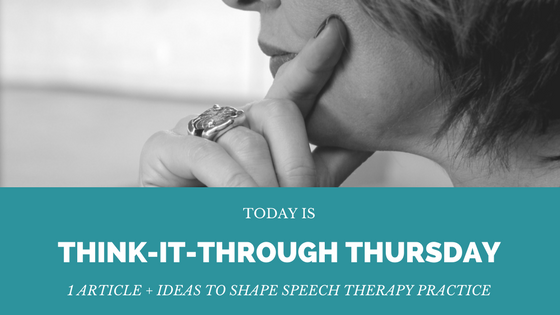It’s Think-It-Through-Thursday! Here’s a new series to give you and your SLP colleagues some food for thought. Feel free to print and discuss at lunch or use for continuing education or journal review! I will include a recent research article and some thoughts about how this relates (or doesn’t relate) to some of the practices we have in adult speech therapy!
Today’s topic: Discourse in Aphasia + High WAB Scores
Article Link: https://ajslp.pubs.asha.org/article.aspx?articleid=2628210 Discourse Characteristics in Aphasia Beyond the Western Aphasia Battery Cutoff (Davida Fromm, Margaret Forbes, Audrey Holland, Sarah Grace Dalton, Jessica Richardson, and Brian MacWhinney, in the AJSLP August 2017. SLP’s have access to this through their ASHA account!)
This article investigates those patients who no longer score below a 93.8 on the WAB (the cut-off for having aphasia according to the test). We’ve all worked with those higher-level patients who can pass the WAB but clearly still report life activity and participation difficulties. Since life participation and activity is our primary outcome focus as SLP’s, we want to take those reports from patients with validity!
The research study concludes that several factors warrant a need for therapy despite high scores on the WAB; factors including “spoken language marked by word errors, slower rate of speech, and decreased essential content will affect conversation, communication, and/or participation.”
 With this knowledge, how might this affect our evaluation? Because standardized testing alone is inadequate and doesn’t speak to functional or in-context tasks, it is vital that our evaluation clearly discusses the life participation and activities of each person. We won’t know they are having difficulties ordering at the drive-through or listening to church sermons or giving reports at work unless our evaluation allows for this sort of discussion. When possible, we should simulate the high-level needs a patient describes during the evaluation (“Let me hear what you would say at the drive-through restaurant.” or “Give me a 5-minute summary about the work you are doing.”) We need to hear actual real-life discourse in our evaluations, and we also need to hear about a person’s unique life activities and participation.
With this knowledge, how might this affect our evaluation? Because standardized testing alone is inadequate and doesn’t speak to functional or in-context tasks, it is vital that our evaluation clearly discusses the life participation and activities of each person. We won’t know they are having difficulties ordering at the drive-through or listening to church sermons or giving reports at work unless our evaluation allows for this sort of discussion. When possible, we should simulate the high-level needs a patient describes during the evaluation (“Let me hear what you would say at the drive-through restaurant.” or “Give me a 5-minute summary about the work you are doing.”) We need to hear actual real-life discourse in our evaluations, and we also need to hear about a person’s unique life activities and participation.
With this knowledge, how might this affect our treatment? Impairment-level tasks will not be appropriate given the high-level of deficits, and the fact that they do not relate to specific activity or participation. Yes, this is a longer way of me saying “Toss the workbooks!” and “Close the game closets!” Treatment will want to be related to functional needs–thankfully, this is right up the alley of what Honeycomb Speech Therapy products are all about. Appropriate treatment tasks could include:
*Simulating home or work tasks (See Home Sweet Home Series and Back To Work Series for hundreds of ideas).
*Recording and critiquing conversation together (Perhaps using Conversation Partner Training Packet to set-up and score!)
*Script Training, specific to home or work situations for the patient.
Thanks for thinking it through! After reading the article, what else might you add to how we could shape our speech therapy practice for these patients?
Make sure you get the latest functional therapy updates: Follow Honeycomb Speech Therapy on Facebook , Pinterest, or Instagram, or sign up for email updates below.
Interesting read! To be fair, I think the WAB is just one tool and is often not appropriate as the sole assessment for high-level patients. So, the type of assessment is also important to identify both specific impairments and functional/pariticipation difficulties. I work in the outpatient/community setting and see mainly high-level aphasia and cognitive-communication folks post stroke and very rarely do the WAB as it doesn’t capture high-level impairments. I do agree with targetting discourse, especially in relation to functional goals, and love your resources! With respect to identifying specific impairments, I would also look at complex sentence comprehension/production, discourse comprehension, and strategy use for discourse production (i.e. are they using compensatory strategies for comprehension/word-finding difficulties). Not to mention, many folks benefit from written self-cueing and use of graphic organizers to formulate written narratives, so high-level reading and writing assessment is paramount (depending on their baseline and goals, of course).
Thanks again for stimulating an interesting discussion!
Thanks for chiming in, Violetta! I totally agree with all above! As with our aphasia and TBI patients, standardized testing results only give us one piece of the puzzle. I like the suggestions you include!